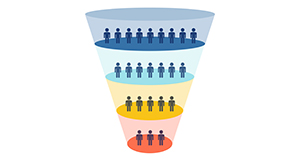How long does it take for a prospective student to choose to enroll in a graduate program?
 It’s been a year, or two, or 5. Are they still considering continuing their education, did they already complete another program or did they give up the dream?
It’s been a year, or two, or 5. Are they still considering continuing their education, did they already complete another program or did they give up the dream?
For some graduate programs, there is fixed window for decisions, while others have a longer lifecycle. Let’s examine typical cycle time from shortest to longest.
1-Year Masters (After Undergrad)
You probably have a year (or 2 max) to catch these students’ attention. They are either super-motivated juniors who are planning their future or exasperated seniors who need to bolster their undergraduate degree to launch a career. If they’ve been in your funnel for over 2 years, it’s worth an email to ask if they’d still like to hear from you.
MBA
Typical lead cycle time for an MBA is 2-3 years. Often, these early career professionals realize after graduating and working for a couple years, that: 1) they don’t like their career choice and need to shift, or 2) they need a broader perspective to move into a leadership role. From this point, it could take a couple of years to prep for an admissions test, find a school and determine the right timing. They have more life decisions at play than a graduating senior, but less than a senior executive. Once they’ve signed up to take a GMAT, you likely have less than 2 years because they will be hit by every school in the country that purchases names of test takers.
EMBA/Global EMBA
Working professionals and aspiring executives who are considering an Executive MBA could be in your funnel up to 5, maybe even 7 years. There are some who know that they want to continue their education, and they want you to keep reminding them (which is why they signed up in the first place and haven’t opted out). There are some that are struggling with barriers like career trajectory, family and personal issues. And for global programs where travel is required, it can be even more difficult to work themselves into a work situation where a boss will give them the time off to pursue a degree. And then there are those who are lifelong learners who may actually be getting another degree in the meantime (yes, this happens). Give them the time they need to make the decision and do all you can to address their concerns. Even though they may seem distant, it’s possible that your messages are getting through and they’ll act when they hear the right one.
Executive Education (Ongoing)
Early-, mid- or late-career professionals and executives either need to fill a knowledge gap right away, or they are pursuing continuing education which means they are always ripe for picking a new program if your offerings coincide with their needs. For this audience, recency and relevance is key because when they’re ready to move, you need to be top of mind.
Online
Prospective students of all career levels that are considering an online education fall in 2 camps. They either need a degree right away to get them to the next level, or they have time to decide and they are banking on ultimate flexibility. While proliferation of online degree programs is up and other free online education options are widely available, give these prospects the most leeway so you don’t lose them.
Find out more about how to engage prospects at different stages of the decision-making process. Contact GPRS.

 Depending on who you talk to — marketing, admissions, administrators, faculty — these may be the most important people in your funnel and the ones that deserve the highest dollar investment. If your leads are qualified, engaged and ripe for the opportunity at hand (your degree program), they will be much more likely to turn into prospects and seated students. Sounds obvious, right? Then why are there so many temptations to shortcut the lead generation process?
Depending on who you talk to — marketing, admissions, administrators, faculty — these may be the most important people in your funnel and the ones that deserve the highest dollar investment. If your leads are qualified, engaged and ripe for the opportunity at hand (your degree program), they will be much more likely to turn into prospects and seated students. Sounds obvious, right? Then why are there so many temptations to shortcut the lead generation process? It’s crunch time. You’re finishing your final round of admissions events for the year. Your class is starting to round itself out, but you’ve still got those final seats to fill. You’re looking at each and every lead in your funnel, trying to predict which ones will take action.
It’s crunch time. You’re finishing your final round of admissions events for the year. Your class is starting to round itself out, but you’ve still got those final seats to fill. You’re looking at each and every lead in your funnel, trying to predict which ones will take action.
